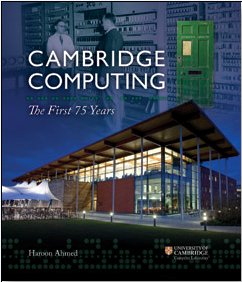Cambridge Computing: The First 75 Years: Book review


The University of Cambridge's Computer Lab has celebrated its first 75 years with, among other things, a readable coffee-table book by Professor Haroon Ahmed. Although packed with historical information, it's more of a souvenir than an academic work, and the numerous photographs will certainly remind the thousands of staff and former students of the Lab's contribution to computing's rapid progress from EDSAC's valves and mercury delay lines to the diminutive Raspberry Pi.
The book is not too constrained by the Computer Lab's actual existence. It starts with two of Cambridge's greatest pioneers, Charles Babbage and Alan Turing, who are both seminal figures in computing. After this pre-history, it takes the 75 years in the title from the founding of the Mathematical Laboratory. Its two staff members helped university researchers tackle numerical problems using mechanical calculators and differential analysers.
The Mathematical Laboratory's greatest era began when Sir Maurice Wilkes returned from war service in 1945. He visited the USA to attend lectures on building digital computers, learned about ENIAC and EDVAC, and decided that Cambridge would build its own digital computer. The result, EDSAC, was the first programmable computer in general service, and several EDSAC users won Nobel prizes. It also led to the world's first business computer, LEO (Lyons Electronic Office). This was built for the tea-shop company, though Leo Computers sold systems commercially.
It wasn't until 1970 that the university set up a separate organisation to provide computing services, but by that time, the Mathematical Laboratory was no longer developing its own machines, such as EDSAC, EDSAC 2 and Titan. The university could buy them from IBM and similar suppliers. Of course, this didn't stop the lab from building useful and interesting research machines like CAP, the "Capabilities computer" used by Bjarne Stroustrup, of C++ fame.
More recently, the Computer Lab was transformed by Wilkes's right-hand man and successor, the late Sir Roger Needham. He supported a deal under which Microsoft contributed to the construction of today's purpose-built lab in the William Gates building, named after the Microsoft co-founder's father. More controversially, Needham also set up Microsoft Research in Cambridge.
The university's computer activities stimulated the development of a "Silicon Fen", and the book includes brief sketches of a few Cambridge-based technology companies that have some connection with the lab. This includes Acorn and its ARM spin-off, Sophos, RealVNC, Jagex (online games), blinkx, and Raspberry Pi. However, there doesn't appear to be any mention of the multi-award-winning software pioneer and entrepreneur Mike Lynch OBE, who did both his degrees at Cambridge and became a fellow of Christ's College. This is odd because Lynch gave a talk during last week's 75th anniversary celebrations.
Lynch built Cambridge's second most successful technology company, and is much more closely associated with the university than the most successful, which is ARM. Of course, Lynch sold his company -- Autonomy -- to Hewlett-Packard for $11 billion, which has resulted in some negative publicity, but he hasn't ceased to exist.
But the main problem with the book is that it's a bit of a patchwork. There isn't even a timeline to give readers not already familiar with Cambridge's history something to hang on to. Dip into it at random and you'll quickly find something entertaining to read, but I found that trying to use it for reference could be somewhat frustrating.
The publisher, TMI, has produced similar glossy tomes about Exeter College: The First 700 Years, The London Oratory School (150 years), UCLA (100 years), Charterhouse, Grosvenor House, Cowdray Park Polo Club and many more. Pre-order a book and you get your name listed in the back, as a Subscriber, and several hundred people are listed in Cambridge Computing. It's not what Cambridge University Press would do, perhaps, but it seems to work.
Cambridge Computing: The First 75 Years
by Haroon Ahmed
TMI
176 pages
ISBN: 9781906507831
£40 plus P&P